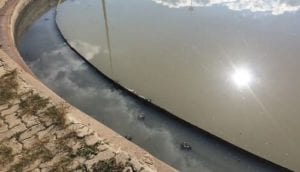Designing information systems for local needs.
By Ulrike Rivett, Michael Champanis and Toni Wilson-Jones Between 1994 and 2012 over 21 million people in South Africa were given access to an improved water source and in 2008 the initiative of Blue Drop certification tackled the challenge of decentralising the monitoring of water sources. The national government has implemented regulations and policies to deliver safe water to all, but some local municipalities have not necessarily caught up with the national guidelines. This is particularly true for rural communities and municipality structures where water supply is only practically reticulated and treated, and a majority of the population still rely on individual boreholes. The low compliance rate is generally explained using reasons such as under-resourcing, skills shortages, lack of understanding of required standards, lack of intervention to address problem areas, inadequate management, and limitation on finances, assets and fiscal accountability.It is widely accepted that rural areas in South Africa are more difficult to manage and monitor due to the limitations highlighted, as well as the geographical layout of a dispersed population and the historical set-up, although some have noted that this may be exaggerated by management practises of controlling limited resources, rather than managing policy implementation. Rural authorities are also not always responsive to legislation and regulatory requirements and consequently water quality monitoring of outlying supplies might only be conducted on an ad-hoc basis. Such ad-hoc information has very limited impact on the identification and prevention of microbiological contamination or on the overall management of water supplies. In this research paper, Rivett et al looks at the findings of a study that investigated the use of a cell-phone-based information system which was implemented in four rural municipalities in South Africa. The study formed part of the Aquatest project, an international research programme, which was established to develop a lost-cost water test for the developing world. It was initiated in 2006 under the European Union’s Sixth Framework Programme. In 2007, the project secured funding from the Gates Foundation for the period from 2008 to 2012. The project consortium included universities in the UK and the US, two US-based non-profit organisations and the iCOMMS team at the University of Cape Town. During the course of the research, it was observed that the apparent inability of rural municipalities to respond to regulations might be closely linked to the structure for decentralising water-quality monitoring to local municipalities. The national monitoring systems that have been put in place in order to maintain an overview – such as the Blue Drop system – may, in their reporting requirements, disadvantage under-resourced municipalities. Decentralisation of a national function can either be merely bureaucratic or can form part of a process of ceding power to a community. Depending on which of the two forms is the basis for the decentralisation, the national monitoring of the decentralised function will vary. In this article it is argued that the current information systems implemented to monitor drinking-water-quality compliance nationally are designed for the economically affluent municipalities who have the ability and means to implement policy and best practises. Small and under-resourced municipalities on the other hand, could be negatively impacted by these systems to the extent that water-quality monitoring has turned into a bureaucratic function that has limited impact on decision-making at local level. Research
The research was structured around a case study of four field sites in rural South Africa. The scope of each case was a single water services authority (WSA), which was responsible for multiple communities in outlying areas and with a dispersed population. It was initially noted that there was little commonality in monitoring programmes between the different WSAs. Thus, one requirement for the system design was that it had to cater for local data and information needs.
The measurements for the improvement of monitoring were:
• An increase in reporting of the water-quality standards in rural areas with borehole water supply.
• An increase in awareness, at managerial level, of the status of rural supply.
• An increase of awareness, at borehole operator level, of the requirements of management, and the need for data collection for national monitoring purposes.
• An increase for awareness regarding problems and issues at the water-supply site.
• An experience of accountability and transparency of the authorities responsible for water-quality monitoring.
• An experience of usefulness of the information for decision-making.
The following generic procedures were followed to develop the system as well as monitor the changes at each of the four WSAs:
• Documentation of existing monitoring programmes.
• Identification of relevant actors within the monitoring, and water-quality management, structures.
• Analysis of the information needs, as identified by local managers, borehole operators and other stakeholders.
• Analysis of the difference between local monitoring practices and national guidelines.
• Re-framing of the findings of the analysis into an information system design that responds to the identified needs.
• Development of a first software application, implementation of the application and observation of the use of the system for a defined period.
• Analysis of the appropriateness of the design and functionality of the system, through interviews with all users and stakeholders.
• Response to findings by refining the design of the system, implementation of the revised application and subsequent observation of the system application for another period of time.
• Assessment of the improvement of the measures above, through another set of interviews with managers and borehole operators, as well as analysis of the data flow between the various stakeholders by analysing the information available on the database. Important to note is that the research design was kept flexible in order to respond to the varying local needs at each site. Whilst the procedures outlined above were adhered to broadly, the number of interviews or the number of stakeholders interviewed varied slightly between sites. The frequency of reporting of water-quality parameters was decided together with the municipalities, based on local needs. The information systems were designed using cell phones as the tool for data collection, information transfer and analysis. The cell phone applications were labelled: the Water Quality Reporter and the Water Quality Manager. The WQR and WQM system The WQR cell phone application was installed on the phone of the water-supply caretaker, who was usually a borehole operator. The caretaker was guided through a number of questions regarding the water quality of the water supply and was asked to select a response. The questions for the operators varied between the WSAs and were decided on in collaboration with the managers and borehole operators. Aspects such as questions relating to water-safety plans or best practises were included and comment boxes allowed operators to provide additional information relating to the physical elements of water-quality monitoring, such as pH, turbidity and electrical conductivity. Once the water-supply caretaker had collected the data, a completed form was sent via GPRS to a central server. Once the form was received at the server, a message manager verified the data and checked its integrity before storing it in the database. A notification and feedback sub-system was configured to send various messages when the sample data were received centrally. The borehole operator sending the data received a message requesting re-capturing if a value was above a limit, or appeared erroneous. The manager with the overall responsibility for water-quality monitoring also received a message, in case a result was outside the acceptable parameters.
After the first phase of the implementation it was realised that most of the managers required a mobile application that allowed them to check the status of their various sites while being outside the office. Thus, the four managers of the municipal field sites were provided with Android phones that had the WQM application loaded. The application allowed each manager to review water-quality testing across all relevant water sources in real time. The system also provided spreadsheets for reporting that could be downloaded via an Internet application. Users were able to decide on the relevant data points and could download reports for a chosen time period for each site. Observations and discussions The observation that different government departments manage water quality in each of the rural municipalities indicates that an understanding of the decentralisation of water-quality management is vital if a national monitoring system is to be successfully implemented. The discipline of e-government and e-governance offers some finding with regards the implementation of national government systems. A study of the e-government literature reveals an academic discourse of overwhelming optimism about the potential of e-government for development. Yet, in over a decade of e-government research, most government information systems projects in the developing world have ended in either partial or total failure.
Systems failure is ascribed to enforcing unwanted or contentious change in organisational processes, or because the technology requirements, such as hardware and connectivity, did not exist or were not maintainable due to limited human, technical and financial resources.
In general, the literature on information systems failure suggests that failure occurs because some aspect of the system context – social, technical or political – is inadequately understood, ignored or underestimated. Based on literature review, the researchers identified that government literature does not discuss the contentious nature of government information system successes. For example, is a project successful if it helps government to carry out a function more effectively, but results in job losses or redundancy in specific social groups? This question does not aim to underestimate the value of efficient and effective technical systems; in fact, most people would agree that a system that improves the delivery of basic services, supports development, or helps citizens hold public bodies to account, is broadly desirable. However, if the information system results in already constrained resources being used to collect information that is only relevant for bureaucratic and reporting purposes, the effectiveness and desirability of a government system could be questioned. Information systems can be experienced as an appropriate tool to support decentralisation of core government function since the design and structure of information systems is hierarchical in nature, which is often a mirror to the monitoring of a decentralised national function. By collecting appropriate information at local level, national government is able to track progress. The experience of the information system in this context is that, due to the system, information is collected that allows the citizen to hold politicians, municipal officers and other public organisation accountable. However, if the system design fails to address the notion of devolving responsibility as part of the decentralisation, it could be argued that the system might be doomed to fail. According to a paper by Brett there are three justifications for decentralisation: • It should improve democratic accountability by allowing the local community to exercise closer control over local politicians.• It should improve management of local services by making local officials directly accountable to local politicians and society at large.
• It should help overcome possible ethnic or sectarian divisions by allowing minority communities to control political decisions.
Brett further makes the argument that, whilst certain aspects of central government have to be delegated to local beurocratic structures, a devolution also means that there is an obligation to cede control to a local municipality that may have differing political structures, different resources or different management structures. In the context of water provision in South Africa, the Constitution, in Schedule 4B, makes clear that the function of providing safe water rests with both national and provincial government. The decentralisation to local level is facilitated based on the notions that Brett has highlighted above. By allowing municipalities to design their own water-quality management structures, it can be expected that municipalities would respond more appropriately to the local needs, and that resources would be allocated appropriately. Thus, control would be ceded to local municipalities and it can be expected that other variables such as resources available to local authorities, the political autonomy and the local democratic process, would be taken care of by the people who know their environment best. However, the challenge of the ceding of control becomes apparent when the national government expects to main a level of control by monitoring the municipality from a distance, through a centralised information system. The BDS was designed as a generic monitoring programme, based on the outline of best practises at national level. This research confirmed that the water-quality monitoring programmes employed in each of the municipalities varied greatly. None of the four municipalities monitored water quality using similar structures, or a generic programme. For example, in one of the study sites, the manager visited each supply site once a month for compliance monitoring, whilst in another site, environmental health officers were tasked with compliance monitoring. Since there are very few environmental health officers, compliance monitoring was often only performed annually. Borehole operators performed weekly operational monitoring tests at some sites, yet these tests were not performed at all in other municipalities. Formal workflows only existed in one of the municipalities. In three of the four municipalities, the person managing the borehole operators and the water supplies was also directly involved in the water-quality compliance monitoring. The managers of water supplies were employed through the Department of Health, the Department of Social Works, the municipality, or the district in different cases. There was no consistency in the requirements of the management function – water-quality monitoring was a minor part of the workload in some instances, due to other job requirements. For the design of an information system that would be applicable nationwide, the functionality and the information collection would be based on assuming a certain set of common denominators. For water-quality monitoring, these denominators are tasked with the various functions. In rural communities, one person often fulfils multiple functions due to limited resources, but also because it is often sufficient to have one person doing multiple tasks. Based on the local context, all municipalities documented the existing workflow and communication requirements between managers and local borehole operators. The system was then designed using the agreed information requirements, some of which included national monitoring requirements. All managers reported an increase in regular communication and an increase in awareness of the status quo of water quality in the various field sites. Since only one of the field sites had a monitoring procedure in place, the reporting of water-monitoring information increased in all of the WSAs. The WQM, as well as the WQR, were experienced as easy to use, due to replicating already existing workflows. Three of the municipalities improved their workflow by amending data requirements after the first revision of the software. Managers also reported that the amount of travel to remote sites was reduced due to being able to assess sites from the office. Managers felt that their confidence in water quality had increased and the system was experienced as providing relevant information for decision-making. All managers felt that they had a better understanding of the movements of the borehole operators and their needs. In some of the sites, the system became an HR management tool and one manager commented that the tool had increased his workload, due to him being more aware of the challenges in one of the outlying villages. One of the issues highlighted by Brett is the notion of democratic accountability. The tension here lies in thinking of accountability in terms of improved management and bureaucratic efficiency and accountability, in terms of improving the accountability of government service providers to the public. Much investment is spent towards addressing the aspects of improved management and bureaucratic efficiency as a measure of improved accountability. This can often be achieved by designing systems which allow tracking of progress or communication of the latest statistics. For example, the Blue Drop system communicates to the public the status of water quality in each municipality of South Africa. However, it neither communicates who is responsible nor who the various accountable local government structures are. The study of the WQR and WQM implementation pointed towards a need to improve the second aspect of accountability regarding government providing services to the public. The ability to keep local records and download reports was experienced as increasing transparency as well as accountability – which was confirmed by both managers and borehole operators. One of the borehole operators had used the WQR application to show community members how water-quality information was communicated to the municipality, and expressed that this resulted in the community feeling more closely linked to the government authorities. Managers felt that national government should include the information collected at local level into the national system, in order to understand the information needs at rural level.








